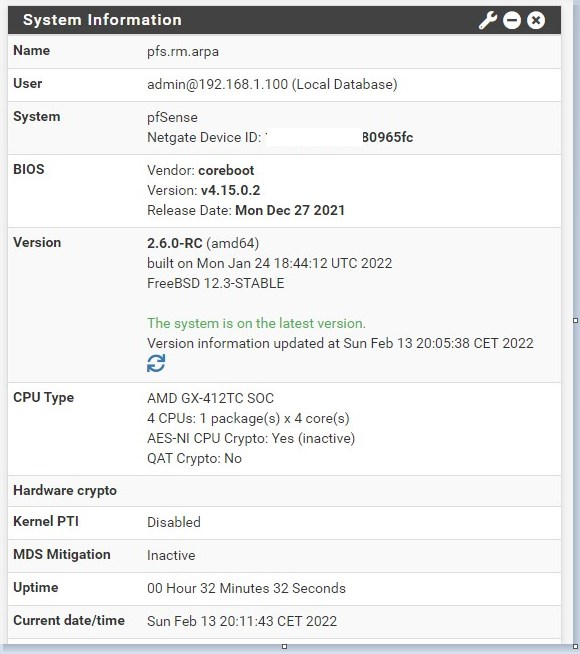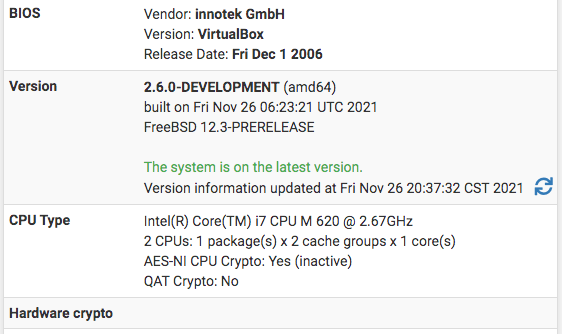FreeBSD 12.3
-
@jimp said in FreeBSD 12.3:
@nollipfsense said in FreeBSD 12.3:
agree and this is what I was speaking of...see image where yellow arrow points to.
Those are rc scripts, nothing to do with the build status/version (which would be a part of the version number, not package name).
Well that just burst my bubble...anyway Jimp, carry on.
-
Hi guys
I know it's not advisable to run the snapshots in a production environment. However I'm interested to see if anyone is and does the bases being updated to freebsd 12.3 introduce any show stopping bugs. I only ask as I like running all my home systems on the bleeding edge of software again I know it's not advisable but is a fantastic way to learn in the event of a crash for debugging code that might not have crashed in a VM/Lab environment.
Thanks
Eoghan -
@eoghan, I have been running 2.6.0 development snapshots for months and have no complaints. If you like living on the edge, go for it.
-
@eoghan I have done it in the pass on 2.5 that was very stable...of course, you'll be at your own risk...just be sure every two or three days you make a backup of your configuration and have a jump drive with 2.6 ready to install...that way you'll be down at most half an hour. Like you, I like to live on the leading edge...too much fun!
-
Once the new version reaches beta status, it is quite safe to try it in non production, (or not very critical) systems.
If your system runs under vm in any case, then its even easier to go this way.
The benefit is that if you find a bug, chances are you will get a fix included in the release.
And yes, you have to use it to find the bug too. -
There can be a bit of a catch-22 here as well. If the vast majority of users swear off using beta or development software, then testing of new versions suffers and bugs (even critical ones) can go unnoticed all the way into release.
I fully understand not wanting to run development or beta software in a critical production system, but in many networks there are opportunities for accepting a bit of risk in the name of testing. For example, maybe for a small business there is a branch office or two where instead of RELEASE pfSense you could run DEVEL. As others have mentioned, running pfSense virtualized is a great way to help in the testing program because you can so easily rollback to a previous snapshot if you encounter a critical error.
One thing Netgate really can't do well in a software development testing lab is reproduce all the different hardware and network setups that exist with users. So having robust participation from a wide array of users in the DEVEL snapshot testing branch is vital to a successful RELEASE update.
-
@eoghan said in FreeBSD 12.3:
Hi guys
I know it's not advisable to run the snapshots in a production environment. However I'm interested to see if anyone is and does the bases being updated to freebsd 12.3 introduce any show stopping bugs. I only ask as I like running all my home systems on the bleeding edge of software again I know it's not advisable but is a fantastic way to learn in the event of a crash for debugging code that might not have crashed in a VM/Lab environment.
Thanks
EoghanNo issues from my side. I have been running it from this summer. But my use case is not your use case. Please make sure you're not installing on your production machine. Please test your use case first.
-
@nrgia But, that's exactly what he wants to do (production mode for home network) and with the proper safeguards mentioned as well as in place, we should encourage him. I find 2.6 to be very stable despite the few bugs to work out.
-
I went one step further with my backup/recovery solution.
Every couple of days I'm doing a complete clone of the ssd the I have pfsense installed on but also keeping a pfsense install usb handy just as another recovery method in case the ssd image fails to apply or something.
-
@nollipfsense said in FreeBSD 12.3:
@nrgia But, that's exactly what he wants to do (production mode for home network) and with the proper safeguards mentioned as well as in place, we should encourage him. I find 2.6 to be very stable despite the few bugs to work out.
I think you misunderstood me. I'm not trying to scare anybody away. But first, just to play it safe, it's good to test your use case on different machine, beeing bare metal or VM. And if it works, then you can upgrade the production one too. At least this is my approach. The backups are also a good thing, but sometimes even a little bit of downtime can cause troubles, why not avoid it?
-
@nrgia Okay...
-
If you didn't notice already starting from today 13/01/2022 my 2.6.0-DEVELOPMENT updated to 2.7.0-DEVELOPMENT.

How about that?
Nevermind I saw the discussion here:
-
@nrgia said in FreeBSD 12.3:
If you didn't notice already starting from today 13/01/2022 my 2.6.0-DEVELOPMENT updated to 2.7.0-DEVELOPMENT.

How about that?
Nevermind I saw the discussion here:
Look at that...my intuition was right on about a 2.6 release 29days ago...
-
@nollipfsense said in FreeBSD 12.3:
Look at that...my intuition was right on about a 2.6 release 29days ago...
Howdy there,
It's been a long time since I've been here, what do you hear about 2.6(?)
in addition to this:
https://redmine.pfsense.org/projects/pfsense/roadmap#2.6.0postponing the rebuilding of the home pfS box waiting for the miracle
BTW:
I'm not that excited, because I haven't had much time lately
-
@daddygo I am currently running pfSense v2.6RC in production mode...upgraded this pass Monday...so far no problem. It even seems that graphs are working in Snort and Suricata in-line mode...big applaud!
-
@nollipfsense said in FreeBSD 12.3:
upgraded this pass Monday...so far no problem.
Thanks for the info, I did it today and threw it on an APu4 for a test....


-
@daddygo Nice...
